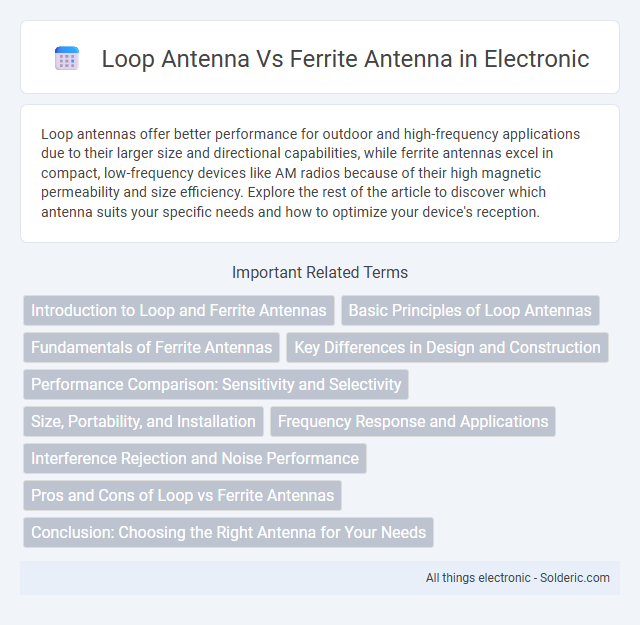Loop antennas offer better performance for outdoor and high-frequency applications due to their larger size and directional capabilities, while ferrite antennas excel in compact, low-frequency devices like AM radios because of their high magnetic permeability and size efficiency. Explore the rest of the article to discover which antenna suits your specific needs and how to optimize your device's reception.
Comparison Table
| Feature | Loop Antenna | Ferrite Antenna |
|---|---|---|
| Design | Wire loop forming a coil | Coil wound around ferrite core |
| Frequency Range | Low to medium frequencies (kHz to MHz) | Primarily medium to high frequencies (especially AM band) |
| Size | Generally larger, varies with frequency | Compact, small form factor |
| Sensitivity | Moderate sensitivity | High sensitivity due to ferrite core |
| Directionality | Directional, used for signal direction finding | Less directional, mainly for receive purposes |
| Use Case | Shortwave listening, radio direction finding | AM radios, portable receivers |
| Cost | Low to moderate | Low to moderate, slightly higher due to ferrite |
| Material | Copper or aluminum wire | Ferrite core with copper winding |
Introduction to Loop and Ferrite Antennas
Loop antennas consist of a wire loop that captures magnetic components of electromagnetic waves, commonly used for direction finding and low-frequency reception. Ferrite antennas incorporate a coil wound around a ferrite core, enhancing magnetic flux sensitivity and efficiency in compact designs, typically found in AM radios and portable receivers. Both antenna types excel in receiving magnetic field signals but differ significantly in size, sensitivity, and typical application environments.
Basic Principles of Loop Antennas
Loop antennas operate based on the principle of electromagnetic induction, where a current induced in the loop by the magnetic field component of an incoming radio wave generates a voltage. They are typically characterized by their small size relative to the wavelength, making them ideal for receiving low-frequency signals with directional sensitivity. Understanding these basic principles helps you optimize antenna selection for specific radio frequency applications, especially when contrasted with ferrite antennas, which use a magnetic core to enhance signal strength.
Fundamentals of Ferrite Antennas
Ferrite antennas utilize a high-permeability ferrite core to concentrate magnetic flux, significantly enhancing the efficiency and sensitivity of the antenna compared to loop antennas with air cores. The ferrite core's magnetic properties increase inductance, allowing for compact design and improved signal reception in AM radio and low-frequency applications. This fundamental characteristic makes ferrite antennas ideal for capturing weak magnetic fields in portable receivers where space and performance are critical.
Key Differences in Design and Construction
Loop antennas consist of a coil of wire forming a closed loop, optimized for magnetic field reception and exhibit directional sensitivity. Ferrite antennas incorporate a ferrite rod as a magnetic core around which the coil is wound, enhancing inductance and signal strength in compact designs. The primary design difference lies in the ferrite core's ability to concentrate magnetic flux, making ferrite antennas ideal for low-frequency AM reception, whereas loop antennas are better suited for applications requiring directional signal detection.
Performance Comparison: Sensitivity and Selectivity
Loop antennas generally offer higher selectivity due to their directional properties, allowing you to better isolate desired signals from interference. Ferrite antennas excel in sensitivity, particularly at lower frequencies, by efficiently capturing magnetic components of electromagnetic waves within compact designs. Choosing between them depends on your specific need for sensitivity in weak-signal environments versus selectivity to minimize adjacent channel noise.
Size, Portability, and Installation
Loop antennas are typically more compact and lightweight, enhancing portability for field use, while ferrite antennas often have a bulkier, rigid core that limits easy transport. Installation of loop antennas is versatile, with options for mounting on tripods or handheld operation, whereas ferrite antennas generally require fixed positioning within receiving devices due to their integrated design. The smaller size and flexible installation of loop antennas make them ideal for mobile and temporary setups, contrasted by the ferrite antenna's suitability for stationary, built-in radio equipment.
Frequency Response and Applications
Loop antennas offer a broad frequency response and are highly effective in receiving low to medium frequencies, making them suitable for HF/VHF applications such as amateur radio and direction finding. Ferrite antennas exhibit a narrower frequency response, optimized for medium wave (MW) and low-frequency AM broadcast bands, commonly used in portable AM radios and signal monitoring. Frequency selectivity and compact size make ferrite antennas ideal for stationary, small-form-factor devices, while loop antennas excel in environments requiring wider bandwidth and directional sensitivity.
Interference Rejection and Noise Performance
Loop antennas excel in interference rejection due to their directional properties, allowing you to minimize unwanted signals by rotating the antenna. Ferrite antennas, commonly used in AM radios, provide good noise performance in compact form factors but are more susceptible to electromagnetic interference. When optimizing for your setup, a loop antenna typically offers superior noise rejection in environments with high RF interference.
Pros and Cons of Loop vs Ferrite Antennas
Loop antennas offer high directional sensitivity and better noise rejection, making them ideal for portable and interference-prone environments; however, they generally require precise tuning and can be bulky. Ferrite antennas are compact, highly efficient for AM reception, and cost-effective, but they suffer from limited directional capabilities and lower performance at higher frequencies. Choosing between loop and ferrite antennas depends on the specific application needs, such as the importance of size, frequency range, and noise immunity.
Conclusion: Choosing the Right Antenna for Your Needs
Loop antennas provide superior directional sensitivity and noise reduction, making them ideal for long-distance and AM radio reception in urban environments. Ferrite antennas offer compact size and efficiency at low frequencies, suited for portable devices and casual listening. Selecting the right antenna depends on your reception goals, device portability, and environmental noise conditions to maximize signal clarity.
loop antenna vs ferrite antenna Infographic

 solderic.com
solderic.com